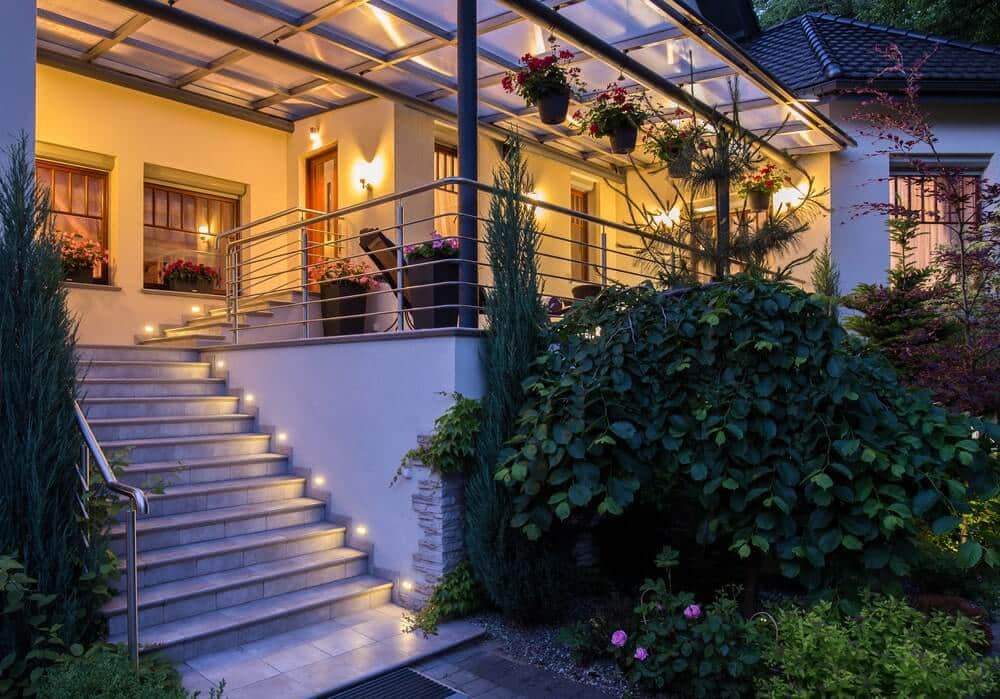
Have you ever seen a professionally lit home that appears ordinary during the day but looks stunning at night? This is what outdoor landscape lighting can do for your home. It literally can transform the average into extraordinary for a modest investment.
Landscape lighting will showcase the exterior of your home, but also make it safer for you and your family to navigate the outdoor spaces. When used creatively, outdoor lighting can create a signature ambiance and showcase the unique characteristics of your home.
This explains why many homeowners consider outdoor lighting to be an investment that pays for itself, as a lifestyle enhancement and selling feature that enhances the value of their property.
Due to the significant impact outdoor lighting has on a home, there are several factors to consider before investing. Let’s look at what you need to know for planning outdoor lighting that is right for your landscape.
#1. Study The Influence Of Ambient Light
One of the most important decisions you must make—and also the hardest—is where exactly to put your outdoor lighting. Start by first looking at your combined outdoor spaces. How big or how small is the area? Are you planning to light the entirety of your space or just parts of it?
Evaluate ambient light sources. This includes moonlight, as well as the impact of light emitted from streetlights and nearby houses. If you live in an urban or suburban area, ambient light may be significant and should inform your decisions about landscape lighting effects.
For example, if your home is in a suburban neighborhood with many houses close to each other, it is probably sufficiently lit for security. Therefore, your outdoor lighting should focus on dramatic effects such as shadows and focal points.
#2. Light Spaces For Desired Effects and Activities
Consider the purpose of landscape lighting to achieve desired outcomes.
- Illuminate walkways and access points to the home
- Highlight unique characteristics of the home or property
- Light spaces where you plan to gather and entertain guests
- Illuminate blind spots for safety purposes
By finding the purpose of the lighting, you can determine the location and the type of light fixture you should use. For example, there are multiple lighting fixture types for the respective lighting outcomes. For example, there are abundant pathlight styles from which to choose. You will discover the light they deliver varies. It turns out the only way to decide for sure is to test them on site. Most suppliers will have samples available for this purpose.
If you are fortunate to have landscaping that is relatively mature, evaluate how you can light these plantings and take advantage of the dramatic effects of their shadows. You will discover there are many ways to light objects, but usually one or two ways that make it special. The point is that anyone can spotlight an object, but a creative mind figures out if uplighting, downlighting, or indirect lighting that grazes the object is best for its location and the ambient light.
#3. Plan For The Current and Future Landscape Design
When choosing the type of outdoor lighting for your home, you should also have in mind what future improvements you could potentially make. If there are no anticipated changes in the immediate future, you’ll at least want to consider how to later accommodate the growth of ornamental trees and shrubs.
If you plan to eventually make future hardscape improvements, such as adding a new patio, you can take a number of proactive steps to make lighting those additions easier and less expensive.
- Bury 1 1/4″ PVC sleeves to avoid later digging through established root systems
- Install lighting transformers with ample power needed for future improvements
- Plan current and future lighting so that their effects complement each other
Experienced lighting designers know that in temperate climates, winter provides opportunities for stunning lighting displays. In contrast to turfgrass, snow covered landscapes will glisten with nearly every source of lighting, especially downlighting and the soft glow from pathlights.

One of the most magical lighting opportunities of winter is when rainfall or wet snow freezes. The droplets hanging from path lights, tree branches and ornamental grasses twinkle from the movement of winter winds. These are a few ways to plan for this.
- Cut down ornamental grasses in early spring, rather than autumn
- Choose substantial path lights that will stand above the snowfall
- Consider uplighting the trunks of shade trees
- Uplight or downlight the outer branches or ornamental trees
#4 Prioritize Year-Round Safety and Security
Landscape lighting placement is also essential for safety reasons. Your outdoor lighting should illuminate a safe pathway towards your house’s main entrance and all other entry points. This includes your driveway and garage.
Safety considerations are paramount for any landscape, especially when features such as pools, ponds, fire pits, and outdoor grills are involved. There should be lighting that alerts people to what’s ahead so that they do not turn a corner and discover the unexpected.
When used incorrectly, lighting can create ‘hot spots’ that can become safety hazards. This occurs when directional lighting is at or about eye level. Sometimes the best way to solve the problem is evaluating the effects of the lighting from all angles.
If you consider all this before investing in outdoor landscape lighting, you will find that what you choose will be the most effective for your property and the season in which you will use it the most. Don’t waste your time or money investing in lighting that doesn’t make sense for your property.
Architectural Landscape Design: Helping Homeowners Enjoy Better Living
Here at ALD, our top priority is creating living spaces that are right for you. Our landscape design team will work with you from concept to construction to create the right landscape for your personal needs. Contact us today for a free consultation to explore your next outdoor living project.
